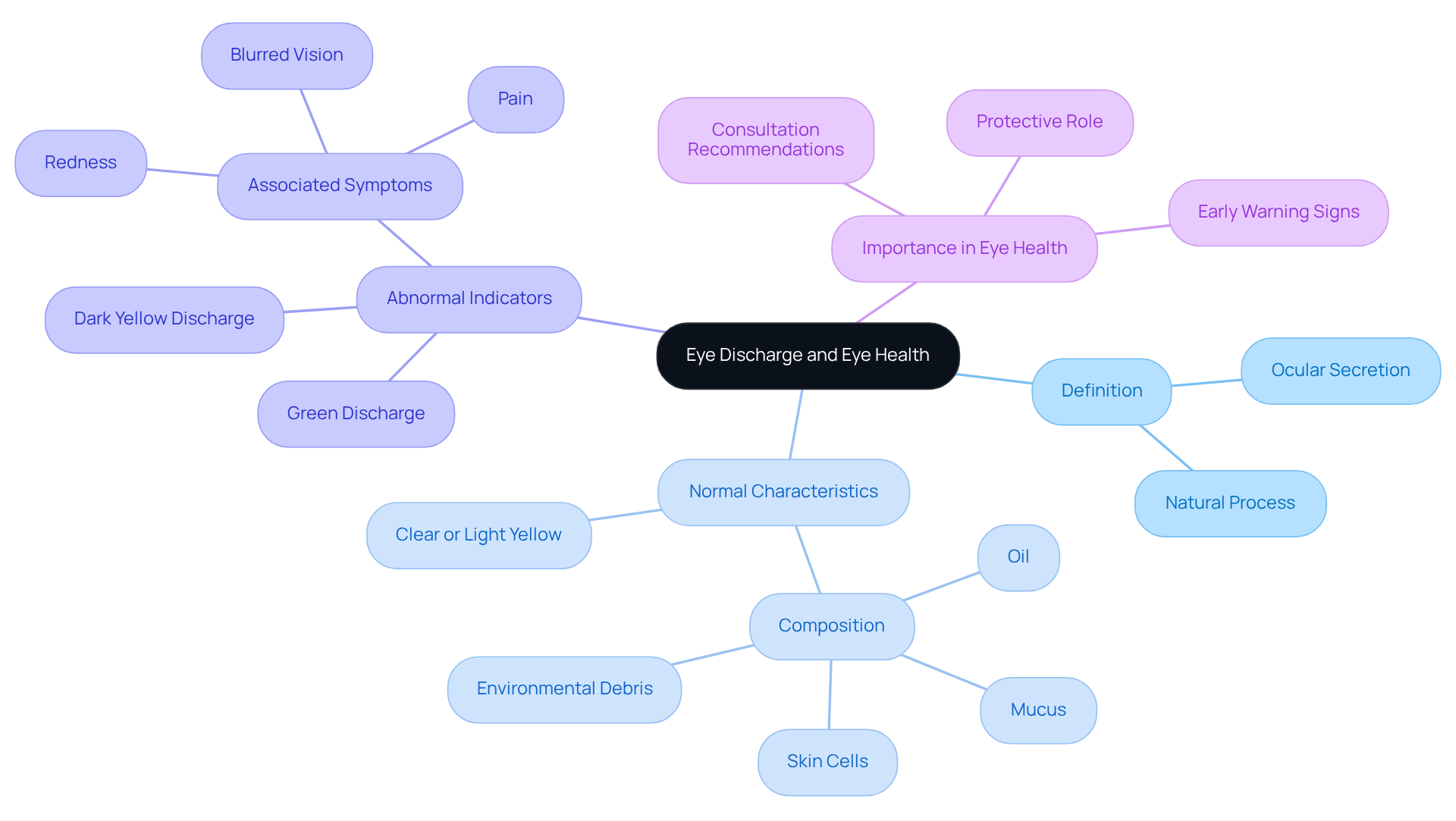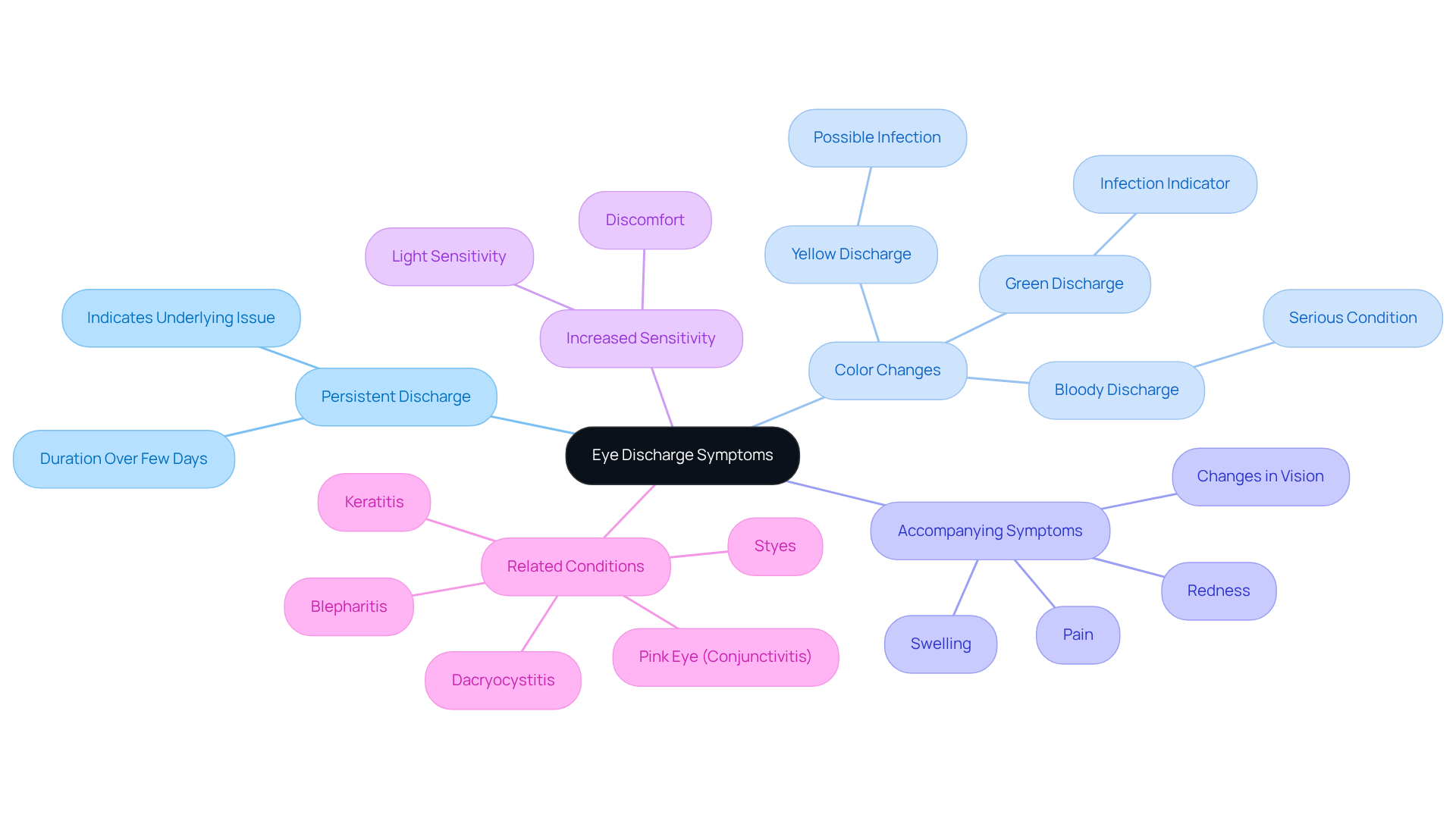Posted by: Northwest Eye in General on June 14, 2025
Overview
Eye discharge, which consists of a mixture of mucus, oil, and debris, is a normal occurrence that plays a vital role in maintaining eye health. However, we understand that noticing changes in its color or consistency can be concerning. These abnormal changes may indicate underlying health issues that deserve attention.
This article outlines various causes, such as infections and allergies, and emphasizes the importance of recognizing symptoms that may warrant further investigation. It’s common to feel uncertain in these situations, but being aware of what to look for can empower you.
We discuss treatment options ranging from home remedies to medical interventions, highlighting the need for timely medical evaluation when necessary. Remember, you are not alone in this journey; we are here to help you through the process and provide the support you need.
Introduction
Understanding eye discharge is crucial for maintaining optimal eye health. This natural secretion serves both protective and diagnostic functions, and it can indicate a range of conditions, from harmless to serious. We understand that noticing changes in discharge can be concerning, and being aware of its characteristics is essential for timely intervention.
What happens when the discharge changes in color or consistency, or is accompanied by discomfort? It’s common to feel uncertain in these situations. Recognizing these signs can be the key to addressing potential health issues before they escalate. We are here to help you through this process.
Define Eye Discharge and Its Importance in Eye Health
Ocular secretion, often referred to as ‘sleep’ in the eyes, is a natural blend of mucus, oil, skin cells, and environmental debris that gathers in the corners of the eyes, especially during sleep. This secretion plays a vital role in protecting your eyes by maintaining moisture and keeping irritants at bay. Typically, normal appears clear or light yellow. However, if you notice excessive or —especially if it’s green or dark yellow—it may signal , such as infections or allergies.
We understand that concerns about can be worrisome. Research shows that healthy eyes produce mucus as part of their natural cleaning process, helping to remove debris and maintain . Monitoring is important, as it can serve as an early warning sign for potential issues. For instance, if you experience , pain, or redness alongside changes in secretion, we recommend .
Comprehending the role of eye secretion in your ocular health is essential for effective management and timely intervention when necessary. At Northwest Eye, we encourage you to be aware of these symptoms and to for a thorough examination. Remember, only a qualified eye care professional can provide an accurate diagnosis. We are here to help you through this process.

Explore Causes of Eye Discharge: Types and Triggers
can occur due to various causes, and we recognize how concerning this can be for you. Let’s explore these causes together, as recognizing them is vital for timely intervention and treatment.
- Normal Secretion: A small amount of is typical, especially upon waking. This indicates healthy eye function and is nothing to worry about.
- : Conditions like are marked by thick, yellow or green fluid. This type of eye discharge often signals an infection that may require antibiotic treatment. In fact, bacterial eye infections represent nearly one-third of all eye-related visits in emergency departments, with an estimated occurrence of 6 million cases each year in the United States. The economic burden of bacterial eye infection is significant, costing approximately USD 857 million annually due to medical expenses and lost productivity. We understand that this can be alarming, but knowing the facts can help you feel more prepared.
- Viral Infections: typically result in watery discharge, often accompanied by redness and irritation. This form is common among children, especially in spring, when peak. It’s important to note that 23% of bacterial eye infection cases occur in children aged 0-2 years, emphasizing the necessity of awareness among various age groups. We want to reassure you that you’re not alone in this experience.
- Allergic Reactions: can lead to clear, watery fluid along with itching and redness, frequently triggered by environmental allergens like pollen or pet fur. It’s common to feel discomfort in these situations, and understanding the cause can help you manage it better.
- Irritants: Exposure to smoke, dust, or chemicals can lead to increased secretion as the eyes attempt to flush out irritants, resulting in discomfort and potential inflammation. We recognize how uncomfortable this can be and encourage you to seek relief.
Understanding the typical reasons for eye discharge, such as , can assist caregivers in addressing issues efficiently and pursuing suitable medical attention when required. Remember, we are here to help you through this process, and seeking care is a positive step towards feeling better.
Identify Symptoms of Eye Discharge: When to Seek Help
While some eye discharge can be a normal occurrence, we understand that certain symptoms may cause concern and warrant prompt medical evaluation:
- : If the discharge lasts more than a few days, it may indicate an underlying issue that requires attention. Remember, this information is not a substitute for professional diagnosis.
- : Discharge that is yellow, green, or bloody often signals an infection, making it important to visit an .
- : The presence of redness, swelling, pain, or changes in vision should prompt immediate consultation with an eye care professional. Recognizing these symptoms is crucial for early diagnosis and treatment, as untreated conditions can lead to serious health complications.
- : Experiencing light sensitivity or discomfort alongside secretion is another critical sign that medical evaluation is needed.
Conditions such as pink eye, keratitis, blepharitis, styes, and dacryocystitis can lead to . Additionally, may be associated with these conditions. Being aware of these signs can lead to early diagnosis and treatment, preventing complications and ensuring improved results for your eye health. We encourage you to learn about and to schedule an appointment if you are experiencing . Remember, we are here to help you through this process.

Discuss Treatment Options for Eye Discharge: From Home Remedies to Medical Interventions
Treatment for eye discharge varies depending on the underlying cause, and understanding these options is crucial for effective management. We know that as a parent, it can be concerning to see your child experiencing discomfort. Here are some approaches to consider:
-
:
- Warm Compresses: Applying a warm, damp cloth can alleviate discomfort and reduce crusting around the eyes, promoting healing. We understand how comforting this simple step can be for both you and your child.
- : Gentle rinsing with saline solution helps clear irritants and reduce fluid release, providing immediate relief. It’s common to feel relieved when you see your child feeling better.
- : Over-the-counter lubricating eye drops can effectively alleviate dryness and irritation, enhancing comfort for your child. We encourage you to keep these handy for those tough days.
-
Medical Treatments:
- : For bacterial infections, prescribed antibiotic drops are essential for clearing the infection. Bacterial conjunctivitis is , primarily affecting children. Studies indicate that more than two-thirds of children diagnosed with acute conjunctivitis received these drops. However, their use should be carefully considered to avoid overtreatment. We know how important it is to get the right care for your child.
- Antihistamines: In instances of allergic reactions, antihistamines can significantly diminish signs and eye discharge, providing relief from discomfort. It’s comforting to know there are options available to help.
- : The American Academy of Ophthalmology (AAO) suggests using over-the-counter painkillers like acetaminophen or ibuprofen for alleviating discomfort. We want you to feel equipped to manage your child’s pain effectively.
- : Persistent or severe cases warrant evaluation by a specialist to determine the most appropriate course of action, ensuring that any underlying issues are addressed promptly. Remember, seeking help is a sign of strength.
By understanding , parents can make informed decisions about their child’s eye health, ensuring timely and effective care. Additionally, utilizing patient education resources like the and symptom checkers can empower you to better understand your child’s condition and the importance of proper management, especially considering the contagious nature of conjunctivitis. We are here to help you through this process, ensuring your child receives the best care possible.
Conclusion
Understanding eye discharge is essential for maintaining your eye health and recognizing potential health issues. This natural secretion not only protects your eyes but also serves as a diagnostic tool, signaling when something may be amiss. We understand that being vigilant about changes in the characteristics of eye discharge—such as color, consistency, and accompanying symptoms—can lead to timely interventions that prevent complications.
This article highlights the various causes of eye discharge, from normal secretion to infections and allergies. It emphasizes the importance of recognizing symptoms that warrant medical attention, such as persistent or colored discharge. Treatment options range from home remedies to medical interventions, providing you with the knowledge to better manage your eye health and seek appropriate care when necessary.
Ultimately, awareness and education about eye discharge empower you to take charge of your eye health. Whether it’s monitoring symptoms or exploring treatment options, being proactive can lead to better outcomes. If you are experiencing concerning changes in your eye discharge, consulting an eye care professional is a crucial step in ensuring optimal eye health and preventing further complications. We are here to help you through this process.
Frequently Asked Questions
What is eye discharge and why is it important for eye health?
Eye discharge, also known as ocular secretion or ‘sleep’ in the eyes, is a natural mixture of mucus, oil, skin cells, and environmental debris that collects in the corners of the eyes, particularly during sleep. It is important for eye health as it helps maintain moisture and protects the eyes from irritants.
What does normal eye discharge look like?
Normal eye discharge typically appears clear or light yellow.
When should I be concerned about my eye discharge?
You should be concerned if you notice excessive or abnormal eye discharge, especially if it is green or dark yellow, as this may indicate underlying health issues such as infections or allergies.
What should I do if I experience changes in eye discharge along with other symptoms?
If you experience changes in eye discharge along with symptoms like blurred vision, pain, or redness, it is recommended to consult a healthcare expert for evaluation.
How does eye discharge contribute to eye health?
Healthy eyes produce mucus as part of their natural cleaning process, which helps remove debris and maintain overall eye health.
Why is it important to monitor changes in eye discharge?
Monitoring changes in eye discharge is important as it can serve as an early warning sign for potential health issues related to the eyes.
What should I do if I have concerns about my eye health?
If you have concerns about your eye health or notice any unusual symptoms, it is advisable to schedule an appointment with a qualified eye care professional for a thorough examination.






